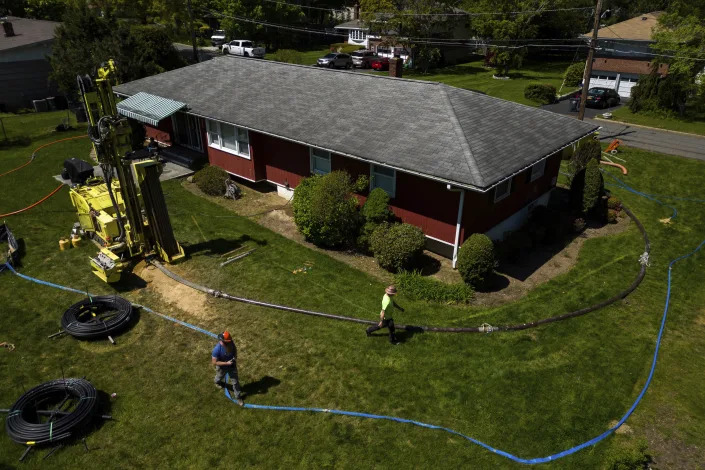


Groundwater squirts up during drilling for a geothermal heating and cooling system at a home in White Plains, N.Y., Monday, May 8, 2023. A water-filled loop installed several hundred feet deep either carries heat away from, or into the house, depending on the season. Industry experts see the technology becoming increasingly popular in the coming years.
(AP Photo/Julia Nikhinson)
ISABELLA O'MALLEY
Thu, July 13, 2023
Some homeowners looking to switch out their heating and cooling systems are turning to home geothermal — also known as ground source — heat pumps. It's a technology that relies on a simple physical fact: Dig several feet below Earth's surface, in the coldest winter or the hottest summer, and the temperature will be around 55 degrees.
Geothermal takes advantage of that constant temperature by pushing water with some antifreeze through a loop of flexible pipe that runs deep underground. The water gets circulated by a heat pump system, usually located in the basement.
When the house needs cooling — say on an 85-degree July day — a refrigerant, which is a special fluid, absorbs unwanted heat indoors and transfers it to water in the long piping, circulating it underground, giving it time to cool to the constant mid-50s below. House air blows across the cool fluid. Having dumped its heat, it can absorb more for transfer to the outdoors.
Warming the building works much the same, in reverse. On a sub-freezing January day, the system circulates the water underground, warming it to about 55 degrees. Arriving back at the pump, the water in the loop now heats the refrigerant, making it want to expand. An electric pump then compresses it, which spikes the temperature. The system then pushes air over the hot refrigerant and into the house until the air in the house reaches thermostat temperature.
In apartment buildings, schools or other commercial buildings, the underground loop may be just a few feet deep and extend horizontally over a wide area. For smaller residential lots, the solution is to drill deeper — as much as 300 feet or more — to get a loop that is long enough for the water be in contact with the ground and equalize with its constant temperature.
Geothermal systems cost more up front than typical furnaces, sometimes tends of thousands of dollars. Supporters say lower operating costs eventually make that worthwhile, because the superpower of ground source heat pumps is that they use very little electricity to move heat around. They're designed to last more than 50 years for the underground parts, with the above-ground components expected to last 25 years or more. Gas furnaces typically last 15 to 30 years on average.
Geothermal or ground-source heat pumps are still the exception rather than the rule. Air-source heat pump are far more common and work by extracting energy from outdoor air to both heat and cool the home.
___
Associated Press climate and environmental coverage receives support from several private foundations. See more about AP’s climate initiative here. The AP is solely responsible for all content.
ISABELLA O'MALLEY
Thu, July 13, 2023
Some homeowners looking to switch out their heating and cooling systems are turning to home geothermal — also known as ground source — heat pumps. It's a technology that relies on a simple physical fact: Dig several feet below Earth's surface, in the coldest winter or the hottest summer, and the temperature will be around 55 degrees.
Geothermal takes advantage of that constant temperature by pushing water with some antifreeze through a loop of flexible pipe that runs deep underground. The water gets circulated by a heat pump system, usually located in the basement.
When the house needs cooling — say on an 85-degree July day — a refrigerant, which is a special fluid, absorbs unwanted heat indoors and transfers it to water in the long piping, circulating it underground, giving it time to cool to the constant mid-50s below. House air blows across the cool fluid. Having dumped its heat, it can absorb more for transfer to the outdoors.
Warming the building works much the same, in reverse. On a sub-freezing January day, the system circulates the water underground, warming it to about 55 degrees. Arriving back at the pump, the water in the loop now heats the refrigerant, making it want to expand. An electric pump then compresses it, which spikes the temperature. The system then pushes air over the hot refrigerant and into the house until the air in the house reaches thermostat temperature.
In apartment buildings, schools or other commercial buildings, the underground loop may be just a few feet deep and extend horizontally over a wide area. For smaller residential lots, the solution is to drill deeper — as much as 300 feet or more — to get a loop that is long enough for the water be in contact with the ground and equalize with its constant temperature.
Geothermal systems cost more up front than typical furnaces, sometimes tends of thousands of dollars. Supporters say lower operating costs eventually make that worthwhile, because the superpower of ground source heat pumps is that they use very little electricity to move heat around. They're designed to last more than 50 years for the underground parts, with the above-ground components expected to last 25 years or more. Gas furnaces typically last 15 to 30 years on average.
Geothermal or ground-source heat pumps are still the exception rather than the rule. Air-source heat pump are far more common and work by extracting energy from outdoor air to both heat and cool the home.
___
Associated Press climate and environmental coverage receives support from several private foundations. See more about AP’s climate initiative here. The AP is solely responsible for all content.


























